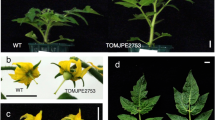Summary
In tomato, nine independent EMS-induced mutants representing recessive mutations at three different loci (gib-1, gib-2, and gib-3) were isolated. Six of these have an almost absolute gibberellin requirement for seed germination and elongation growth. In addition, the leaves are darker green, smaller, and changed in structure as compared to wild type. The three other mutants, which germinate without GA, are allelic to specific, nongerminating mutants and have less severe mutant characteristics. The respective loci are situated on three different chromosomes. The genes identified by these mutants control steps in gibberellin biosynthesis, as endogenous gibberellins are strongly reduced.
Similar content being viewed by others
References
Bensen RJ, Zeevaart JAD (1990) Comparison of ent-kaurene synthetase A and B activities in cell-free extracts from young tomato fruits of wild-type and gib-1, gib-2, and gib-3 tomato plants. J Plant Growth Regul 9: (in press)
Bohner J, Hedden P, Bora-Haber E, Bangerth F (1988) Identification and quantitation of gibberellins in fruits of Lycopersicon esculentum, and their relationship to fruit size in L. esculentum and L. pimpinellifolium. Physiol Plant 73:348–353
Graebe JE (1987) Gibberellin biosynthesis and control. Annu Rev Plant Physiol 38:419–465
Groot SPC, Karssen CM (1987) Gibberellins regulate seed germination in tomato by endosperm weakening: a study with gibberellin-deficient mutants. Planta 171:525–531
Groot SPC, Bruinsma J, Karssen CM (1987) The role of endogenous gibberellin in seed and fruit development of tomato: Studies with a gibberellin-deficient mutant. Physiol Plant 71:184–190
Groot SPC, Kieliszewska-Rokicka B, Vermeer E, Karssen CM (1988) Gibberellin-induced hydrolysis of endosperm cell walls in gibberellin-deficient tomato seeds prior to radicle protusion. Planta 174:500–504
Hildering GJ, Verkerk K (1965) Chimeric structure of tomato plants after seed treatment with EMS and X-rays. The use of induced mutations in plant breeding. Pergamon Press, Oxford, pp 317–320
Jensen J, Jörgensen JH (1975) The barley chromosome 5 linkage map. Hereditas 80:5–16
Jones MG (1987) Gibberellins and the procera mutant of tomato. Planta 172:280–284
Jupe SC, Causton DR, Scott IM (1988) Cellular basis of the effects of gibberellin and the pro gene on stem growth in tomato. Planta 174:106–111
Koornneef M, Stam P (1987) Procedures for mapping by using F2 and F3 populations. Arabidopsis Inf Serv 25:35–40
Koornneef M, Veen JH van der (1980) Induction and analysis of gibberellin-sensitive mutants in Arabidopsis thaliana (L.) Heynh. Theor Appl Genet 58:257–263
Koornneef M, Veen JH van der, Spruit CJP, Karssen CM (1981) The isolation and use of mutants with an altered germination behavior in Arabidopsis thaliana and tomato. In: Kitto PH (ed) Induced mutations — a tool in plant research IAEA-SM-251. IAEA, Vienna, pp 227–232
Koornneef M, Cone JW, Dekens RG, O'Herne-Robers EG, Spruit CJP. Kendrick RE (1985a) Photomorphogenic responses of long hypocotyl mutants in tomato. J Plant Physiol 120:153–165
Koornneef M, Elgersma A, Hanhart CJ, Loenen-Martinet EP van, Rijn L van, Zeevaart JAD (1985b) A gibberellin-insensitive mutant of Arabidopsis thaliana. Physiol Plant 65:33–39
Koornneef M. Bosma TDG, Jong JH de, Ramanna MS, Veen JH van der (1986) Yellow-green (yg-6) is an allele of aurea (au). Tomato Genet Coop Rep 38:8–9
Mutschler M, Tanksley SJ, Rick CM (1987) Linkage map of tomato. Tomato Genet Coop Rep 37:5–34
Nadhzimov UK, Jupe SC, Jones MG, Scott IM (1988) Growth and gibberellin relations of the extreme d x tomato mutant. Physiol Plant 73:252–256
Nester JE, Zeevaart JAD (1988) Flower development in normal tomato and a gibberellin-deficient (ga-2) mutant. Am J Bot 75:45–55
Pelton JS (1964) Genetic and morphogenetic studies of angiosperm single-gene dwarfs. Bot Rev 30:479–512
Perez AT, Marsh HV, Lachman WH (1974) Physiology of the yellow-green 6 gene in tomato. Plant Physiol 53:192–197
Plummer TH, Tomes ML (1958) Effects of indoleacetic acid and gibberellic acid on normal and dwarf tomatoes. Bot Gaz 119:197–200
Reid JB (1990) Phytohormone mutants in plant research. J Plant Growth Regul 9:97–111
Sawhney VK, Greyson RI (1979) Interpretations of determination and canalization of stamen development in a tomato mutant. Can J Bot 57:2471–2477
Soost RK (1959) Effects of gibberellic acid on genetic characters in tomato. Bot Gaz 121:114–118
Zeevaart JAD (1986) Characterization of three single-gene dwarf mutants of tomato. J Cell Biochem S10B:33
Author information
Authors and Affiliations
Additional information
Communicated by H.F. Linskens
Rights and permissions
About this article
Cite this article
Koornneef, M., Bosma, T.D.G., Hanhart, C.J. et al. The isolation and characterization of gibberellin-deficient mutants in tomato. Theoret. Appl. Genetics 80, 852–857 (1990). https://doi.org/10.1007/BF00224204
Received:
Accepted:
Issue Date:
DOI: https://doi.org/10.1007/BF00224204




